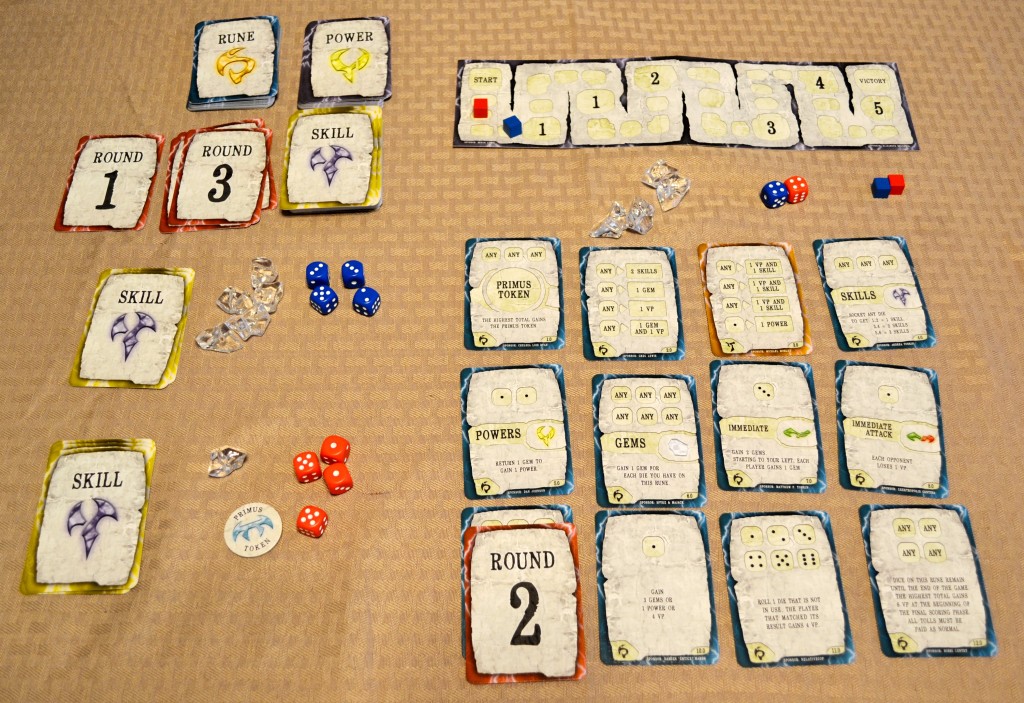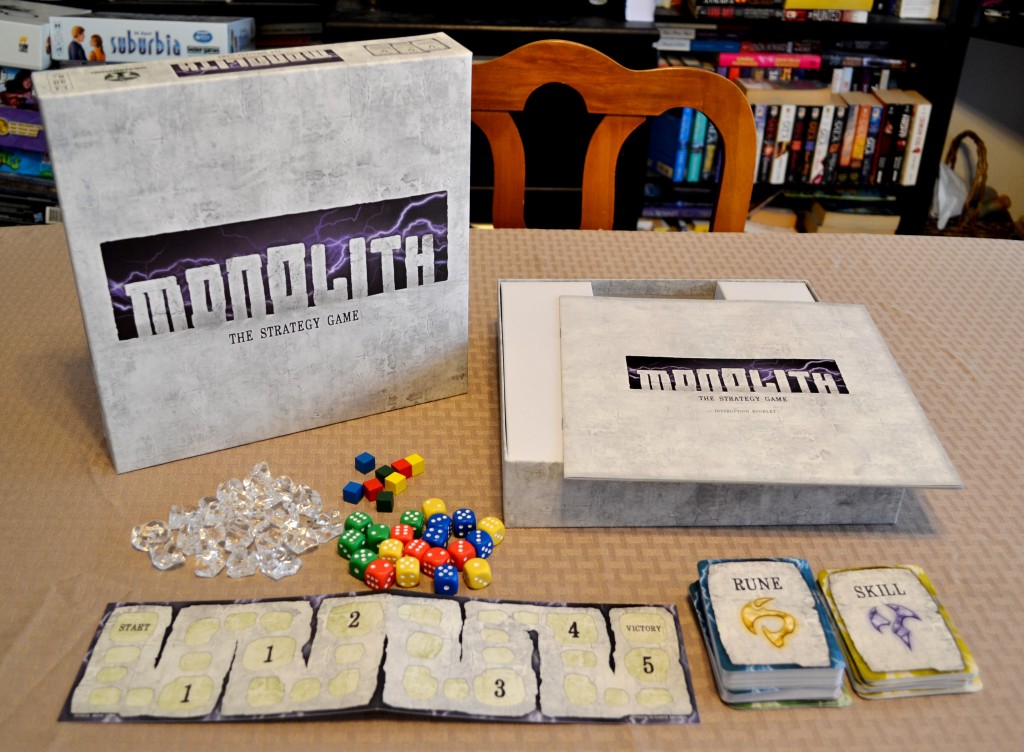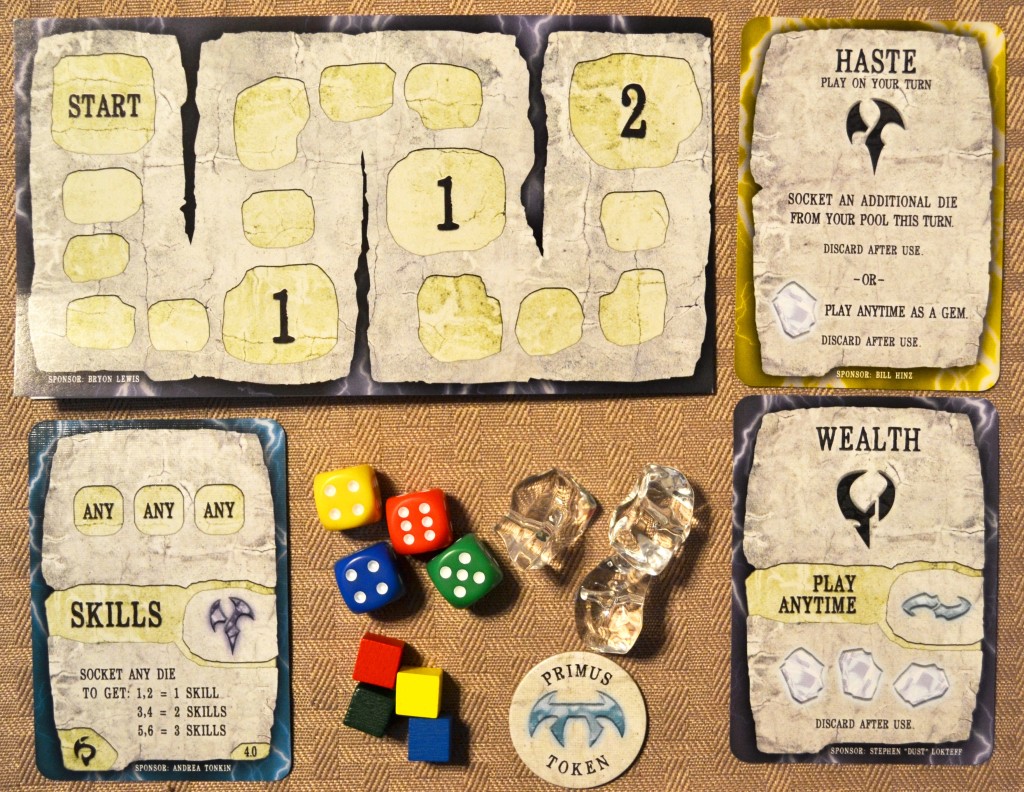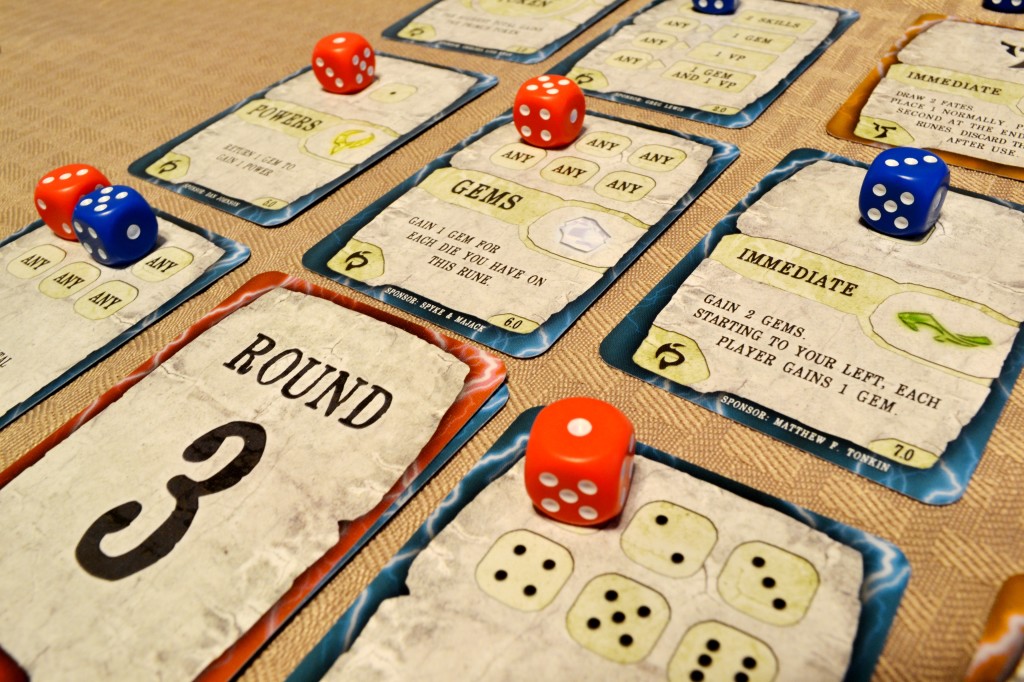“Monolith”, as best as I can describe it, is a dice-rolling worker placement game. Players will be challenged to place their dice on the available cards in such a way that earns them both gems and victory points. While timing and placement in games like these are crucial to success, using powers and skills strategically may give players the edge they might need to win the game. It’s a bit like “Roll For It!”, only a bit more complex. Before we start rolling those dice and seeing what’s what, I’d like to thank Michael Lubbers from Goblin Army Games for providing me with a free press copy.
Components
Rune Cards – These are the core cards that make up the majority of the board. They include sockets, keywords, and effects.
Fate Cards – Similar to rune cards, these are a bit less common and offer more variety in terms of effects.
Skill, Power, & Player Power Cards – These three card types, in a sense, are action cards that can be used to manipulate a number of different things during gameplay.
Round Cards – Round card help players to keep track of how far along the game has progressed. They feature an optional “exalted” reverse side that allows the card to act like a rune card.
Score Track & VP Markers – These help players to keep track of their score as the game progresses. The former includes spaces known as “toll stones” that require the player to pay gems to pass them.
Gems – The form of currency in this game and used to pay tolls on the score track.
Dice – Players will roll and assign these to the sockets listed on the available rune/fate/round cards in order to gain some type of benefit.
Primus Token – This first player token will change hands from round to round, giving them the ability to choose the round card side for that round (among other things).
Setup & Gameplay
There are roughly eight steps to set up the game, but I’ll attempt to provide you all with an abridged version to keep the review moving. Essentially, there are two main areas: “The Source” and “The Game Board”. The source includes the four different decks (skill, power, rune, round), the VP track & markers, gems, and dice. The game board includes a total of twelve cards (eleven rune, one fate), laid face up in three rows (four cards per row). These spaces are numbered one through twelve, starting from the top left corner going across and then down like if you were reading a book. Some cards have numbers listed on them in the bottom right corner so you know were to assign them on the grid. The first six slots are fixed, while the last six slots can either be random or fixed. Players take three starting dice of their color, leaving the rest in the source to be acquired later. There’s a bit more to it than that so check out the PDF/rulebook I linked at the end of this section if you want more details.
The game itself is broken up into five rounds. For the first round, the player with the primus token will start off by rolling two dice and placing the round card on the corresponding face up card on the game board. Rolling a six, for example, will result in the current round card being placed overtop the sixth card on the grid. This effectively makes it out of play for this round. As I mentioned in the components section, the round card has two sides and it’s up to the player with the primus token as to which side will be utilized. The rest of the round is broken up into the chance phase, the action phase, the resolution phase, and the advancement phase.
Chance Phase – In this phase, players roll their current pool of dice and note their values.
Action Phase – Starting with the player with the primus token, each player will assign one of their rolled dice onto any open socket on the board. Effects are not resolved immediately, unless otherwise stated on the card. Action cards can be played here to modify dice and the like, though once a player runs out of dice, they won’t be able to play any more action cards until the following round. A player’s hand size cannot exceed five cards unless otherwise specified.
Resolution Phase – Effects are resolved starting with the first card/slot. If multiple dice are on the same card, the die listed first is resolved first. As effects are resolved, the dice are removed from the cards and given back to their respective players. Some effects grant victory points while others provide action cards and/or gems. Should a player attempt to move their victory point marker onto a toll space, they’ll need to pay that many gems to the source in order to do so. The primus token can also change hands here, depending on who makes use of the first rune card on the grid.
Advancement Phase – The player with the primus token will roll two dice to determine where the next round card will go on the grid. The previous round card is removed from play. Any action cards played return to their owner’s hands. Each player will also receive an extra die of their color from the source, if available.

With a new rune card covered every round, it’s anyone’s guess as to what you’ll have access to at any one time.
The winner of the game is the person highest on the track after five rounds. Bonus victory points are awarded based on a player’s remaining gems, moving their marker one VP per gem (maximum of six) paying any tolls crossed as normal. Should someone reach the “victory” space during the course of the game, they win immediately.
The above doesn’t cover everything in the manual, but should give you the general idea as to how the game is played. For more information, you can find the manual here:
http://boardgamegeek.com/filepage/84043/monolith-rulebook
The Review
I’ll be honest for a moment here (aren’t I always?), part of what prompted me to reach out to the developer and request a press copy was the art. I followed the game on and off since it was featured and funded through Kickstarter back in July 2012 and it’s unfortunate that I didn’t have the time to cover it until now. Everything from the box art to ambience on the cards really blew me away when I first discovered the game. I’m personally a fan of dark, sleek, and contrasting color schemes (those who follow my photography works know what I’m talking about). Now that I’ve had a chance to physically hold it in my hands…well, it made me a happy camper. I had no complaints with the quality of the components either and the manual was relatively an easy read. The latter averages to about ten pages, not including the credits and white space.
The first thing I’d like to note is that gameplay will vary greatly depending on how many people are playing. There’s a solo variant in the manual that challenges the player to make it past toll stone four, though they’ll only have six rune/fate cards available to them on the grid. It’s a great alternative to Solitaire, if you have the space available to play while you’re on the go. Two player games play a lot differently than four player games, mainly due to the glaring absence of what I call “slot blocking”. In most worker placement games I played, some spaces would be blocked off based on the number of people playing so as to limit the available options. There isn’t anything like that here, giving two players almost complete freedom to do as they please. Blocking becomes more strategic and frequent as you add more players to the game. I may try experimenting with only using six or eight rune/fate cards instead of twelve for a two player game, just to see how that balances out.
Along those lines, “Monolith” offers a lot of flexibility in terms of available options. Most cards have more than one socket, giving players (in most cases) thirty or more effects with which to choose. That, coupled with the fact that cards/sockets are resolved in order, make the game very strategic. Usually players are at the mercy of luck in dice rolling games, though I didn’t feel that here. That is…no matter what I rolled, I usually felt that I had at least a few good moves available to me. This becomes more problematic with four players mind you, though rarely was a left with dice that I couldn’t place. The fact that round cards are double-sided and rune/fate cards can be fixed or randomized on the game board only furthers the validity of the topic sentence. If you want to get really crazy, you can switch out some of the rune/fate cards on the game board every round…I personally haven’t tried it, but I would imagine it would prove interesting.
“Monolith”, despite having what some might call a complex setup, is fairly easy to play. The learning curve is low to moderate with games lasting anywhere from thirty to forty-five minutes. First time players may want to give themselves about an hour. The biggest hurdle is figuring out how the cards tie together and how the effects work. With so many options available, first time players and casual gamers might feel a bit overwhelmed with choices. Jennifer and Carolyn (both casual gamers), for example, didn’t like “Wrong Chemistry” because of how many choices lay before them every game turn. As an experienced gamer myself, I’ve come to appreciate just how deep “Monolith” really is because of those available choices. This game really favors those who have the ability to look at what their opponents are doing and react accordingly.
To that end, I’d highly recommend “Monolith” to anyone who isn’t intimidated by semi-deep and strategic gameplay. It plays quickly, making it ideal for school nights or as a filler for long gaming sessions. My only real complaint was the balance via the lack of the aforementioned “slot blocking”, though the game seems flexible enough to work around it if you’re creative enough. Otherwise, it’s a solid dice-rolling worker placement game as worker placement games go. “Monolith” features a ton of replayability and is backed up by some amazing visuals, giving it a consistent appeal factor. This one’s definitely a keeper.
Final Verdict: 8/10
—
You can learn more about and purchase “Monolith” by visiting the following websites:
http://www.goblinarmygames.com/
—



